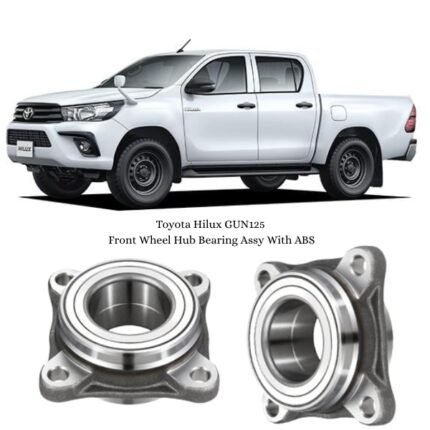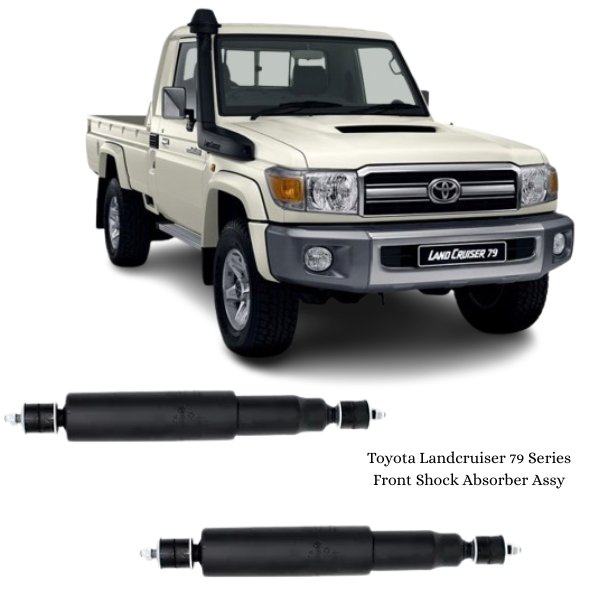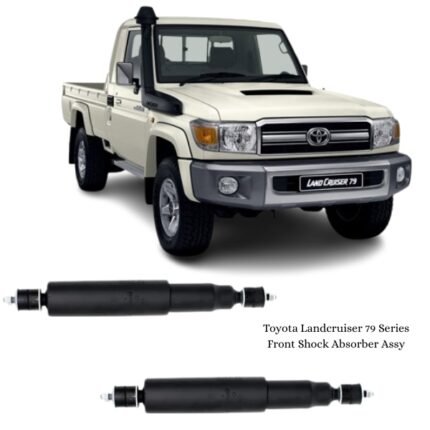Get Toyota Landcruiser 79 Series Front Shock Absorber Assy 48511-69645 in Kenya
The Front Shock Absorber Assembly is a vital component of a vehicle’s suspension system, designed to control the movement of the suspension and maintain tire contact with the road. It plays a crucial role in ensuring a smooth, comfortable ride, while also improving handling, braking stability, and overall safety. Every bump, pothole, or uneven road surface creates energy that must be absorbed and managed, and that is exactly what the shock absorber assembly is engineered to do — dampen vibrations, reduce oscillations, and keep the vehicle stable under all driving conditions.
1. Overview and Function
The Front Shock Absorber Assembly, often referred to simply as a front strut or damper, is a hydraulic device that regulates the up-and-down movement of the vehicle’s suspension. When the wheels encounter an irregular surface, the springs compress and rebound to absorb the impact. Without shock absorbers, these oscillations would continue, making the vehicle bounce uncontrollably. The shock absorber converts kinetic energy from these movements into thermal energy (heat), which is then dissipated through the hydraulic fluid inside.
By controlling the rate at which the suspension springs compress and rebound, the shock absorber ensures that the tires maintain consistent contact with the road surface — enhancing steering precision, braking performance, and passenger comfort.
2. Key Components of the Front Shock Absorber Assembly
The front shock absorber assembly typically consists of several interconnected parts, each playing a specific role in ensuring smooth performance and longevity:
-
Shock Absorber (Damper): The main component that controls the motion of the suspension by converting movement into heat energy.
-
Piston Rod: A polished steel rod that moves in and out of the shock body as the suspension compresses or rebounds.
-
Cylinder (Tube): The outer casing that houses the piston, hydraulic fluid, and valving components.
-
Piston and Valve System: These control the flow of hydraulic fluid through precisely designed orifices, determining the rate of damping.
-
Coil Spring (in strut-type assemblies): Supports the weight of the vehicle and absorbs initial impact forces.
-
Upper Mount and Bearing Plate: The mounting point where the assembly connects to the vehicle’s chassis; the bearing plate allows the strut to rotate smoothly when steering.
-
Dust Boot and Bumper Stop: Protects the piston rod from dirt and debris while limiting excessive compression.
This combination of mechanical and hydraulic components allows the shock absorber to function efficiently under varying road and load conditions.
3. Working Principle
The operation of the Front Shock Absorber Assembly is based on hydraulic damping. Inside the shock absorber, a piston moves through oil-filled chambers as the suspension compresses and rebounds. The piston has small valves that allow controlled movement of fluid between chambers.
When the vehicle encounters a bump:
-
Compression Stroke: The wheel moves upward, forcing the piston rod into the shock body. The hydraulic fluid is pushed through the compression valves, which resist motion and absorb energy.
-
Rebound Stroke: As the spring pushes the wheel back down, the piston moves outward. The rebound valves restrict fluid flow again, controlling the return speed and preventing excessive oscillation.
This process repeats constantly, ensuring smooth and stable handling while reducing shock and vibration transmitted to the cabin.
4. Materials and Construction
The Front Shock Absorber Assembly is built using precision-engineered materials designed to withstand high pressure, heat, and continuous movement. Common materials include:
-
High-Grade Steel: Used for the main tube and piston rod due to its strength and resistance to bending or deformation.
-
Alloy Aluminum: In some designs, lightweight aluminum components reduce overall weight and improve fuel efficiency.
-
Hydraulic Oil: A specially formulated fluid resistant to foaming and heat degradation, ensuring consistent damping performance.
-
Rubber and Polyurethane: Used in bushings and seals to absorb minor vibrations and prevent fluid leakage.
-
Protective Coatings: Anti-corrosion coatings such as zinc or phosphate plating enhance durability and resistance to environmental factors.
These materials ensure the assembly remains durable and reliable, even under heavy loads or rough driving conditions.
5. Types of Front Shock Absorbers
Different designs are used depending on vehicle type and performance requirements:
-
Twin-Tube Shock Absorber:
The most common design, consisting of an inner and outer tube. It offers a comfortable ride and is widely used in passenger vehicles. -
Mono-Tube Shock Absorber:
Features a single, larger tube with a floating piston separating gas and oil chambers. It provides better cooling and consistent performance, suitable for high-performance or off-road applications. -
Gas-Charged Shock Absorber:
Uses nitrogen gas to minimize oil foaming, providing faster response and improved stability on rough roads. -
MacPherson Strut Assembly:
A structural component that combines the shock absorber and coil spring into a single unit, commonly used in front suspensions for compact and mid-sized cars.
Each design serves a specific balance between comfort, handling, and durability.
6. Importance in Vehicle Performance
The Front Shock Absorber Assembly influences multiple aspects of vehicle performance and safety, including:
-
Ride Comfort: Absorbs shocks and vibrations, ensuring a smoother ride.
-
Handling and Stability: Maintains consistent tire contact with the road for precise steering control.
-
Braking Efficiency: Reduces weight transfer during braking, shortening stopping distance.
-
Tire Longevity: Prevents uneven tire wear by keeping wheels stable and aligned.
-
Reduced Body Roll: Minimizes body movement during cornering and acceleration.
In essence, the shock absorber ensures the vehicle responds predictably and safely in all driving conditions.
7. Signs of a Worn or Faulty Front Shock Absorber Assembly
Over time, the front shock absorbers wear out due to continuous motion and exposure to road elements. Common symptoms of failure include:
-
Excessive Bouncing: The vehicle continues to bounce after hitting a bump.
-
Nose Diving: The front end dips sharply during braking.
-
Uneven Tire Wear: Poor damping causes the tires to lose consistent contact with the road.
-
Fluid Leakage: Visible oil on the shock body indicates internal seal damage.
-
Steering Instability: Reduced damping causes vibration or wandering while driving.
-
Clunking or Knocking Sounds: Worn mounts or internal damage can produce noise when driving over uneven surfaces.
If any of these symptoms appear, prompt inspection and replacement are necessary to restore safe driving performance.
8. Installation and Maintenance
Modern shock absorbers are sealed units and require no regular maintenance, but proper installation is crucial for long service life. During replacement, it’s essential to:
-
Replace shocks in pairs to maintain balance and uniform performance.
-
Check associated suspension components such as mounts, bushings, and coil springs.
-
Use proper torque settings on mounting bolts.
-
Ensure alignment after installation to prevent uneven tire wear.
While regular maintenance is not required, periodic inspection of the suspension system during servicing helps detect early signs of wear or leakage.
9. Advantages of a High-Quality Front Shock Absorber Assembly
-
Enhanced Ride Quality: Smooths out road imperfections for maximum comfort.
-
Improved Safety: Reduces braking distance and improves vehicle stability.
-
Durability: High-quality seals and coatings ensure a long lifespan.
-
Consistent Damping Performance: Maintains predictable handling in varying conditions.
-
Reduced Component Wear: Minimizes stress on suspension joints and tires.
-
Superior Road Grip: Keeps all tires firmly in contact with the ground, even on uneven surfaces.
A well-functioning shock absorber assembly not only improves comfort but also safeguards other critical components of the suspension and steering systems.
Follow us on Facebook for more parts.





Reviews
Clear filtersThere are no reviews yet.